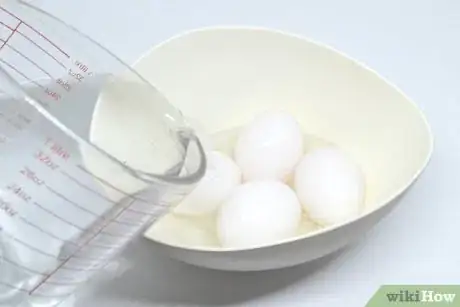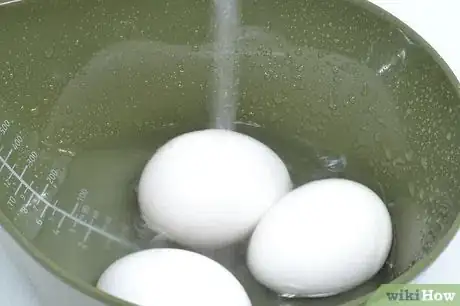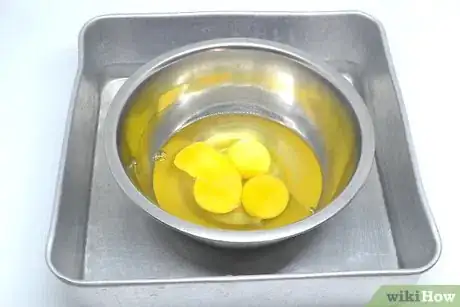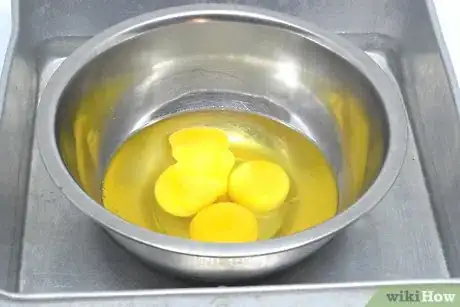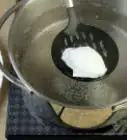This article was co-authored by wikiHow Staff. Our trained team of editors and researchers validate articles for accuracy and comprehensiveness. wikiHow's Content Management Team carefully monitors the work from our editorial staff to ensure that each article is backed by trusted research and meets our high quality standards.
This article has been viewed 28,657 times.
Learn more...
Many baking recipes call for room-temperature eggs, since eggs at this temperature mix more easily into dough and help batter attain a higher volume. Of course, the easiest way to is to read the recipe well in advance and pull your eggs out of the fridge about 30 minutes before preparing the meal.[1] If you’re short on time, though, you can warm the eggs by placing them in warm water or letting warm water run over the eggs. Finally, you could also warm cracked eggs in a stainless steel bowl.
Steps
Warming the Eggs in Static Water
-
1Place the required number of eggs into a kitchen bowl. Pull as many eggs as your recipe calls for out of the fridge. Then, select a bowl from your kitchen and place the eggs into the bottom of the bowl.[2] Set them in place gingerly, so that none of the eggs break or crack.
- The size of the bowl will depend on the number of eggs the recipe calls for. A 6 in (15 cm) soup bowl will suffice for 2–4 eggs. If you’re making a large, multi-layered cake and need to warm a full dozen eggs, you’ll need to use a larger 12 in (30 cm) mixing bowl.
-
2Fill the bowl with warm tap water until the eggs are covered. Turn on your kitchen tap. Run the water until it’s warm to the touch, but not hot.[3] You want the water to be about 75–80 °F (24–27 °C). Once the water is warm, set the bowl under the tap and fill it about 2/3 full.
- Don’t fill the bowl up to the very top, or it’ll overflow when you stick your hand in.
Advertisement -
3Let the eggs warm up for 5–10 minutes. The eggs will warm relatively quickly in the warm water. While the eggs warm up, gather the rest of the ingredients you’ll need for the recipe. Every 2–3 minutes, dip your hand into the water and touch 1 or 2 of the eggs. Once they feel the same temperature as the water, they’re ready to use.[4]
- You can set the warmed eggs on a dry towel so they dry off.
-
4Use the eggs immediately after they’ve warmed. If you let warm eggs sit out for an hour or 2 after you’ve brought them to room temperature, they’ll deflate and won’t fluff up well in your baked goods. So, crack them once they’re warm and then start baking![5]
Running Warm Water Over Your Eggs
-
1Place the necessary number of eggs into a large liquid measuring cup. Pull a 1 cup (240 mL) or 2 cups (470 mL) liquid measuring cup out of your cabinet. Gently set the number of eggs that your recipe calls for into the bottom.[6]
- You’ll want to set the eggs in a smaller container than you’d use for the first method. In this method, it’s important that the warm tap water continually displaces the cooling water around the eggs.
-
2Run 80–85 °F (27–29 °C) water over the eggs. Turn on your kitchen tap and let the water warm up. Place the bowl containing eggs under the faucet, and keep the water running until the bowl fills up. Let the water overflow once the bowl is full. The addition of new warm water to the bowl will speed up the rate at which the eggs attain room temperature.[7]
- You’ll use warmer water when letting it continually run over the eggs, compared to the water temperature when letting the eggs sit in a bowl of water.
- You can use a liquid thermometer to measure the temperature of the water. If you don’t have one, you can estimate the temperature of the water on your skin.
-
3Pull the eggs out after the water has run over them for 2–5 minutes. It won’t take long for your eggs to reach room temperature under the warm running water. After 2 minutes have passed, reach in and touch the eggs. If they’re no longer cold from the fridge, pull them out. If the eggs still feel chilly, let the water run over them for another 2–3 minutes.[8]
- If you leave the eggs under the running water for too long, they may cook inside their shells.
Heating Cracked Eggs in a Stainless Steel Bowl
-
1Break the required number of eggs into a stainless steel bowl. The size of the bowl will vary based on the number of eggs. However, unless you’re using a couple dozen eggs, a 10 in (25 cm) bowl should suffice.[9] Break the shells on a flat surface (e.g., a countertop) to avoid getting shell pieces into your bowl when you crack the eggs.
- If the recipe calls for only yolks or whites, you’ll need to separate the eggs before adding the required yolks or whites to the bowl.
-
2Fill a large baking pan with hot 85 °F (29 °C) tap water. You’ll need a pan that’s large enough to hold the base of the stainless steel bowl. Run the tap water until it’s hot (but not quite steaming) and fill the large pan about halfway full.[10] If you have a liquid thermometer, you can measure the water temperature. Otherwise, you’ll have to estimate.
- Instead of a baking pan, you could also use a very large, shallow casserole dish. To hold the steel bowl, it would need to be at least 12 inches (30 cm) wide and long.
-
3Set the stainless steel bowl into the hot water. The heat from the water will pass through the steel and into the cold eggs. This method gives you greater control over the precise temperature of the eggs, since you can easily monitor how warm the eggs are.[11]
- With this method, you can also monitor the temperature of the eggs themselves, rather than just the outer shells.
-
4Dip a finger into the eggs to test their temperature every 2 minutes. Once the eggs have started warming up, use 1 or 2 fingers to test their temperature. Stick your finger into the deepest part of the bowl. The eggs will have reached room temperature and are ready to be used in baking once they don’t feel cool or warm to the touch. They should be warm in about 5–7 minutes.[12]
- You can use a liquid thermometer to test the egg temperature as well. Pull them out when they’ve reached 70 °F (21 °C).
- Make sure to always wash your hands before touching food, and wash them again after handling raw eggs.
-
5Finished.
Things You’ll Need
Static Water
- Eggs
- Kitchen bowl
- Warm water
- Dry towel (optional)
Running Water
- Eggs
- Large liquid measuring cup
- Running water
- Liquid thermometer (optional)
Cracked Eggs
- Eggs
- Stainless steel bowl
- Large baking pan
- Liquid thermometer (optional)
References
- ↑ http://bakingbites.com/2011/02/how-to-bring-eggs-to-room-temperature/
- ↑ https://www.thekitchn.com/the-easiest-way-to-quickly-warm-eggs-113345
- ↑ https://www.thekitchn.com/the-easiest-way-to-quickly-warm-eggs-113345
- ↑ https://www.thekitchn.com/the-easiest-way-to-quickly-warm-eggs-113345
- ↑ https://www.thekitchn.com/the-easiest-way-to-quickly-warm-eggs-113345
- ↑ http://www.sophisticatedgourmet.com/2016/04/quickly-bring-eggs-room-temperature/
- ↑ http://www.sophisticatedgourmet.com/2016/04/quickly-bring-eggs-room-temperature/
- ↑ http://www.sophisticatedgourmet.com/2016/04/quickly-bring-eggs-room-temperature/
- ↑ https://www.southernliving.com/kitchen-assistant/should-eggs-be-room-temperature-baking-cookies

